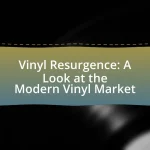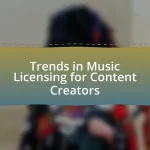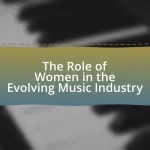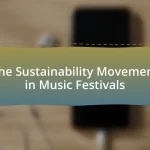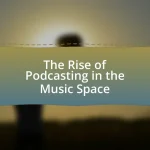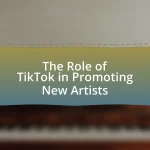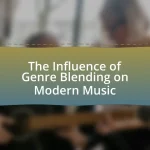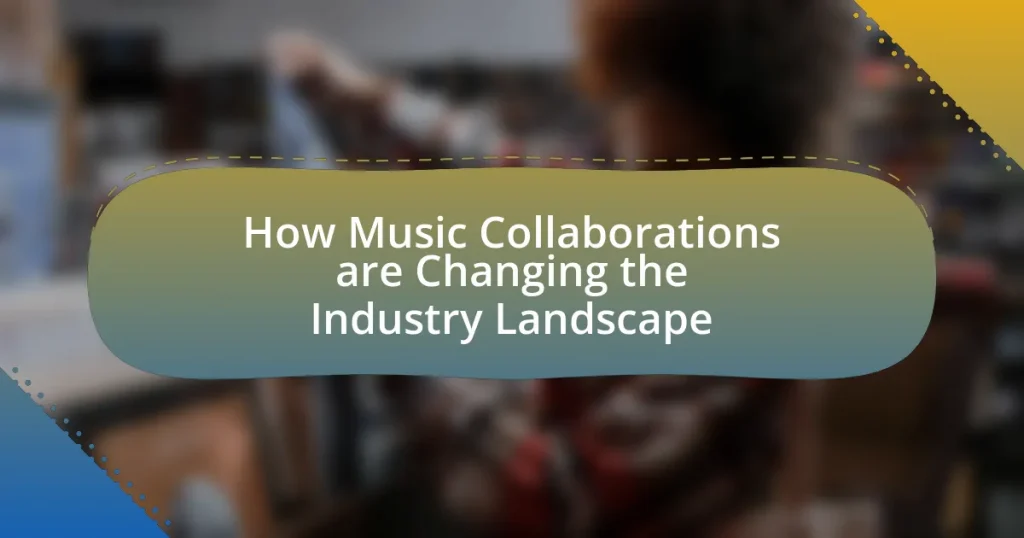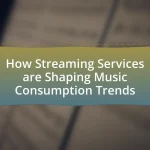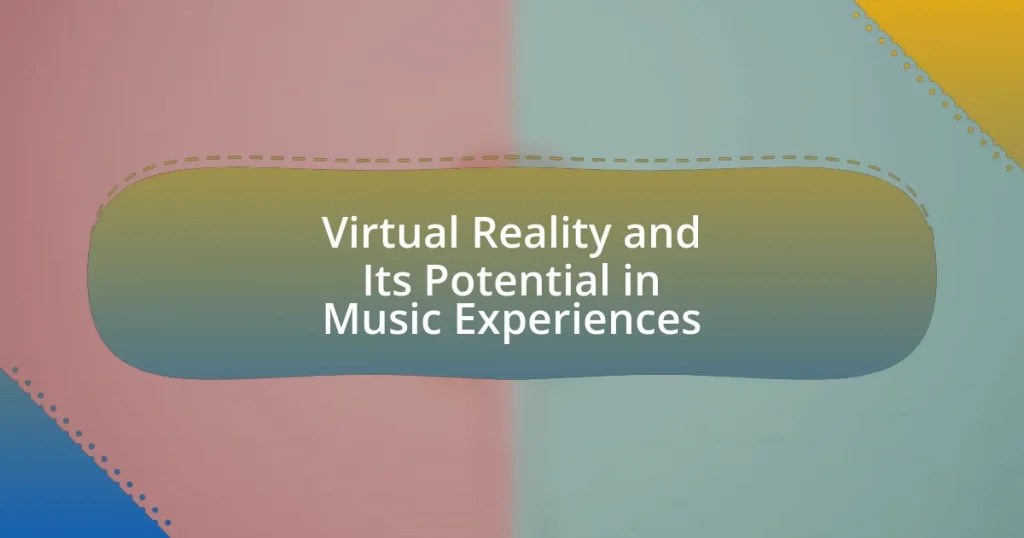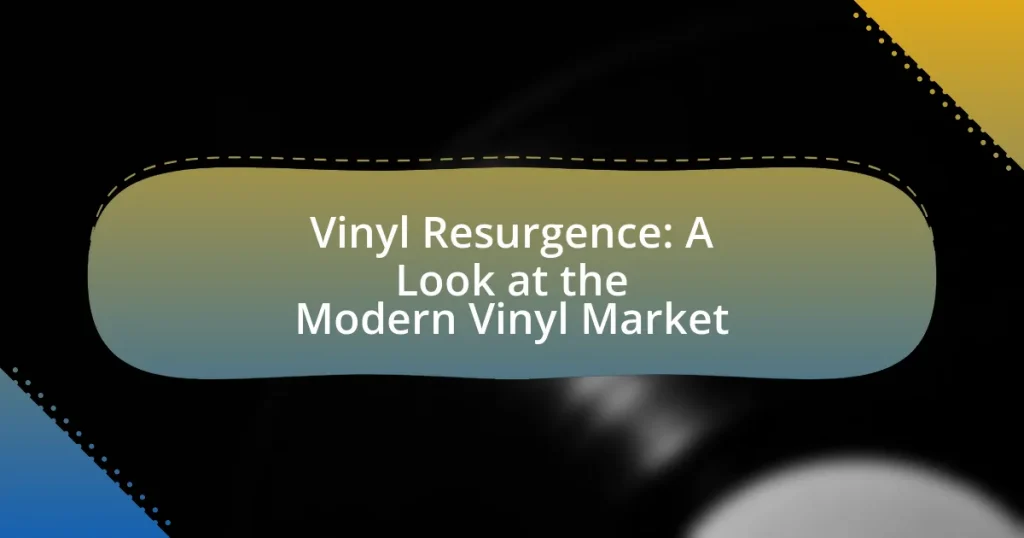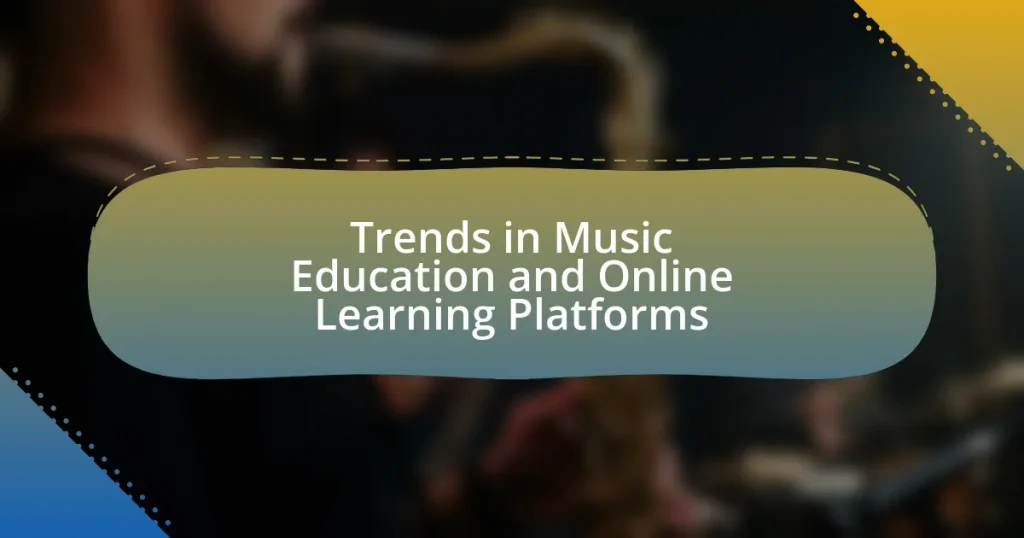Music collaborations are significantly transforming the industry landscape by promoting cross-genre experimentation and broadening audience reach. These partnerships enable artists to blend diverse musical styles, resulting in innovative sounds that appeal to various demographics. Key factors driving this trend include the rise of digital platforms, genre blending, and the influence of social media, which facilitate connections and enhance visibility. Additionally, technology plays a crucial role in enabling remote collaborations, while social media platforms help artists engage with fans and promote their work. The article explores the benefits, challenges, and economic implications of music collaborations, highlighting their impact on creativity, market demands, and the overall music industry.

How are Music Collaborations Transforming the Industry Landscape?
Music collaborations are transforming the industry landscape by fostering cross-genre experimentation and expanding audience reach. These partnerships allow artists to blend diverse musical styles, resulting in innovative sounds that attract listeners from various demographics. For instance, the collaboration between Lil Nas X and Billy Ray Cyrus on “Old Town Road” not only topped charts but also broke genre barriers, demonstrating the commercial viability of such partnerships. Additionally, data from the International Federation of the Phonographic Industry (IFPI) indicates that collaborations have become a significant trend, with over 50% of the top-charting songs in recent years featuring multiple artists. This trend highlights how collaborations are reshaping music consumption and production, making the industry more inclusive and dynamic.
What are the key factors driving music collaborations today?
The key factors driving music collaborations today include the rise of digital platforms, genre blending, and the influence of social media. Digital platforms like Spotify and Apple Music facilitate easy access to a global audience, encouraging artists to collaborate across geographical boundaries. Genre blending allows artists to reach diverse fan bases, as seen in successful collaborations between pop and hip-hop artists. Additionally, social media amplifies these collaborations, enabling artists to promote their work and engage with fans directly, which has been shown to increase streaming numbers and overall visibility.
How has technology influenced the rise of music collaborations?
Technology has significantly influenced the rise of music collaborations by enabling artists to connect and create across geographical boundaries. Digital platforms such as social media, cloud-based software, and online collaboration tools allow musicians to share ideas, files, and feedback in real-time, fostering a collaborative environment. For instance, services like Splice and Soundtrap facilitate remote collaboration, allowing artists from different locations to work together seamlessly. Additionally, the accessibility of recording technology has democratized music production, enabling independent artists to collaborate with established musicians, thus expanding the diversity and reach of music collaborations. This shift is evidenced by the increase in cross-genre collaborations and the rise of virtual bands, which have become more prevalent in the digital age.
What role do social media platforms play in facilitating collaborations?
Social media platforms play a crucial role in facilitating collaborations by providing artists with tools to connect, share, and collaborate in real-time. These platforms enable musicians to reach a global audience, allowing them to discover potential collaborators across geographical boundaries. For instance, platforms like Instagram and TikTok have been instrumental in launching collaborative projects, as artists can showcase their work and engage with others through comments, direct messages, and shared content. According to a study by the Berklee College of Music, 70% of musicians reported that social media helped them find collaborators, highlighting its effectiveness in fostering creative partnerships.
Why are artists increasingly choosing to collaborate?
Artists are increasingly choosing to collaborate to enhance creativity and reach broader audiences. Collaborations allow artists to blend different styles and influences, resulting in innovative music that appeals to diverse listener demographics. For instance, a study by Nielsen Music in 2018 revealed that songs featuring multiple artists often achieve higher chart positions and streaming numbers, indicating a commercial advantage. Additionally, collaborations can leverage each artist’s fan base, creating cross-promotion opportunities that amplify visibility and engagement. This trend reflects a strategic shift in the music industry, where collaboration is seen as a pathway to greater success and artistic exploration.
What benefits do artists gain from collaborating with others?
Artists gain several benefits from collaborating with others, including enhanced creativity, access to new audiences, and the sharing of resources. Collaborating allows artists to combine their unique skills and perspectives, leading to innovative works that may not have been possible individually. For instance, a study by the University of California found that collaborative projects often result in higher-quality outputs due to the diverse input from multiple creators. Additionally, partnerships can introduce artists to each other’s fan bases, significantly expanding their reach and visibility in the industry. This is supported by data from Spotify, which shows that collaborative tracks often achieve higher streaming numbers compared to solo releases, indicating a broader audience engagement.
How do collaborations enhance creativity and innovation in music?
Collaborations enhance creativity and innovation in music by combining diverse perspectives and skills from different artists. This fusion of ideas often leads to unique sounds and styles that may not emerge in solo projects. For instance, the collaboration between David Bowie and Queen on “Under Pressure” resulted in a groundbreaking blend of rock and pop elements, showcasing how two distinct musical identities can create something innovative. Additionally, research from the Journal of Creative Behavior indicates that collaborative environments stimulate creative thinking by encouraging risk-taking and experimentation, further supporting the notion that partnerships in music can lead to significant artistic breakthroughs.
What challenges do artists face in music collaborations?
Artists face several challenges in music collaborations, including creative differences, communication barriers, and logistical issues. Creative differences often arise when artists have distinct visions or styles, leading to conflicts during the songwriting or production process. Communication barriers can stem from varying levels of experience or differing expectations, which may hinder effective collaboration. Logistical issues, such as scheduling conflicts and geographical distances, can complicate the collaboration process, making it difficult for artists to coordinate their efforts. These challenges can impact the overall quality and success of the collaborative project.
How can conflicts arise during collaborative projects?
Conflicts can arise during collaborative projects due to differences in creative vision among team members. When individuals have varying ideas about the direction of a project, it can lead to disagreements and tension. For instance, in music collaborations, artists may have distinct styles or preferences that clash, resulting in disputes over song composition, production choices, or overall artistic direction. Research indicates that 70% of collaborative projects experience some form of conflict, often stemming from miscommunication or differing expectations. This highlights the importance of clear communication and alignment on goals to mitigate potential conflicts in collaborative settings.
What are the legal considerations involved in music collaborations?
Legal considerations in music collaborations include copyright ownership, contractual agreements, and revenue sharing. Copyright ownership determines who holds the rights to the music created, which is crucial for protecting the intellectual property of all collaborators. Contractual agreements outline the roles, responsibilities, and expectations of each party, ensuring clarity and reducing disputes. Revenue sharing agreements specify how profits from the collaboration will be divided, which is essential for fair compensation. These elements are vital for safeguarding the interests of all contributors and fostering a successful partnership in the music industry.
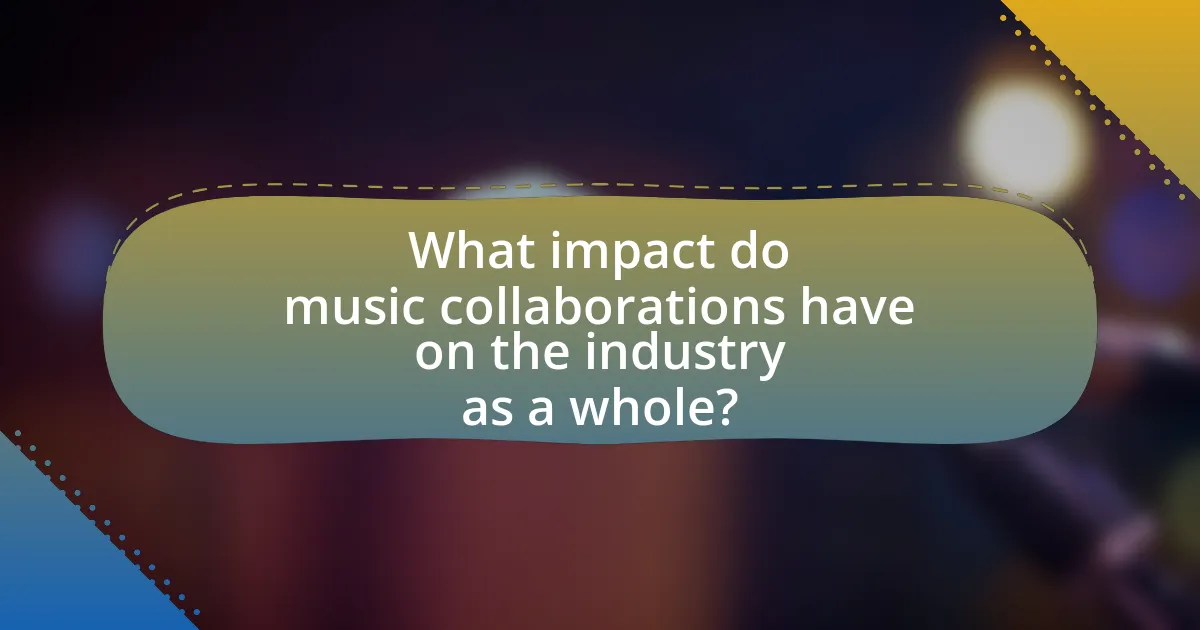
What impact do music collaborations have on the industry as a whole?
Music collaborations significantly enhance the industry by fostering innovation and expanding audience reach. These partnerships often blend diverse musical styles and genres, resulting in unique sounds that attract listeners from various demographics. For instance, the collaboration between Lil Nas X and Billy Ray Cyrus on “Old Town Road” not only topped charts but also broke genre barriers, demonstrating how cross-genre collaborations can lead to unprecedented commercial success. Additionally, collaborations can leverage the fan bases of multiple artists, amplifying marketing efforts and increasing streaming numbers. According to a report by Nielsen Music, collaborations accounted for 25% of the top 100 songs in 2019, highlighting their prevalence and impact on mainstream music consumption.
How do collaborations influence music genres and trends?
Collaborations significantly influence music genres and trends by blending diverse styles and expanding audience reach. When artists from different genres collaborate, they create hybrid sounds that can lead to the emergence of new subgenres, as seen with the rise of country-pop collaborations like those between Lil Nas X and Billy Ray Cyrus, which propelled “Old Town Road” to unprecedented success. This fusion not only attracts fans from both genres but also encourages experimentation, pushing artists to innovate and redefine their musical boundaries. Furthermore, collaborations often generate buzz and media attention, amplifying the visibility of both artists and their respective genres, thereby shaping current trends in the music industry.
What are some notable genre-blending collaborations that have emerged?
Notable genre-blending collaborations include the partnership between Lil Nas X and Billy Ray Cyrus on “Old Town Road,” which fused country and hip-hop, achieving significant commercial success and cultural impact. Another example is the collaboration between Dua Lipa and Elton John on “Cold Heart,” which combines pop and dance elements with classic rock influences, showcasing the evolving sound of contemporary music. Additionally, the collaboration between Post Malone and Ozzy Osbourne on “Take What You Want” merges rock and hip-hop, further illustrating the trend of artists crossing genre boundaries to reach wider audiences. These collaborations reflect a growing trend in the music industry where genre limitations are increasingly blurred, leading to innovative sounds and broader appeal.
How do collaborations shape listener preferences and market demands?
Collaborations shape listener preferences and market demands by merging diverse musical styles and fan bases, leading to increased engagement and broader appeal. For instance, when artists from different genres collaborate, they attract their respective audiences, which can result in a significant rise in streaming numbers and sales. A notable example is the collaboration between Lil Nas X and Billy Ray Cyrus on “Old Town Road,” which not only topped charts but also demonstrated how genre-blending can create new listener demographics and preferences. This phenomenon is supported by data showing that tracks featuring collaborations often achieve higher chart positions and streaming counts compared to solo efforts, indicating a direct correlation between collaborations and market demand.
In what ways do collaborations affect music distribution and marketing?
Collaborations significantly enhance music distribution and marketing by expanding audience reach and leveraging combined fan bases. When artists collaborate, they tap into each other’s established audiences, which can lead to increased streams and sales. For instance, the collaboration between Ed Sheeran and Justin Bieber on “I Don’t Care” resulted in over 1 billion streams on Spotify, showcasing how partnerships can amplify visibility. Additionally, collaborations often generate more buzz and media coverage, which can lead to higher engagement on social media platforms. This increased visibility can drive more traffic to streaming services and digital platforms, ultimately boosting distribution effectiveness.
How do collaborative projects leverage cross-promotion strategies?
Collaborative projects leverage cross-promotion strategies by combining the audiences and marketing resources of multiple artists or brands to enhance visibility and reach. This approach allows each participant to tap into the established fan bases of their collaborators, thereby increasing exposure and engagement. For instance, when two musicians collaborate on a track, they can promote the song across their respective social media platforms, leading to a broader audience reach. According to a study by Nielsen Music, collaborations can lead to a 50% increase in streaming numbers compared to solo releases, demonstrating the effectiveness of cross-promotion in driving audience engagement and sales.
What role do record labels play in facilitating collaborations?
Record labels play a crucial role in facilitating collaborations by providing resources, connections, and industry expertise that artists may lack independently. They often have established networks of artists, producers, and songwriters, which enables them to pair artists for collaborative projects that can enhance creativity and broaden audience reach. For instance, major labels like Universal Music Group and Sony Music have successfully orchestrated high-profile collaborations, such as the partnership between Dua Lipa and Elton John, which not only increased visibility for both artists but also generated significant commercial success. This demonstrates how record labels actively shape the collaborative landscape in the music industry, leveraging their influence to create opportunities that might not occur without their involvement.
What are the economic implications of music collaborations?
Music collaborations significantly enhance economic outcomes for artists and the industry. They lead to increased revenue streams through shared fan bases, which can amplify sales of music, merchandise, and concert tickets. For instance, a collaboration between artists can result in a 50% increase in streaming numbers, as seen with the song “Sicko Mode” by Travis Scott featuring Drake, which achieved over 1 billion streams. Additionally, collaborations often attract sponsorships and brand partnerships, further boosting financial gains. The combined marketing efforts and cross-promotion strategies employed in collaborations can also reduce individual marketing costs, making it economically advantageous for all parties involved.
How do collaborations impact revenue streams for artists?
Collaborations significantly enhance revenue streams for artists by expanding their audience reach and creating diverse income opportunities. When artists collaborate, they often tap into each other’s fan bases, leading to increased sales of music, merchandise, and concert tickets. For instance, a study by Nielsen Music found that collaborations can boost streaming numbers by up to 50%, as fans of both artists engage with the new content. Additionally, partnerships can lead to joint tours and promotional events, further diversifying revenue sources. This strategic alliance not only elevates individual artist profiles but also fosters a more dynamic music ecosystem, ultimately driving higher earnings.
What are the financial risks associated with collaborative projects?
Collaborative projects in the music industry carry several financial risks, including revenue sharing disputes, increased production costs, and potential for financial loss if the project fails to generate expected income. Revenue sharing disputes can arise when collaborators have differing expectations about how profits will be divided, leading to conflicts that can delay or derail projects. Increased production costs may occur due to the need for additional resources, such as hiring session musicians or producers, which can strain budgets. Furthermore, if a collaborative project does not resonate with audiences, the financial investment may not be recouped, resulting in losses for all parties involved. These risks highlight the importance of clear agreements and financial planning in collaborative music ventures.
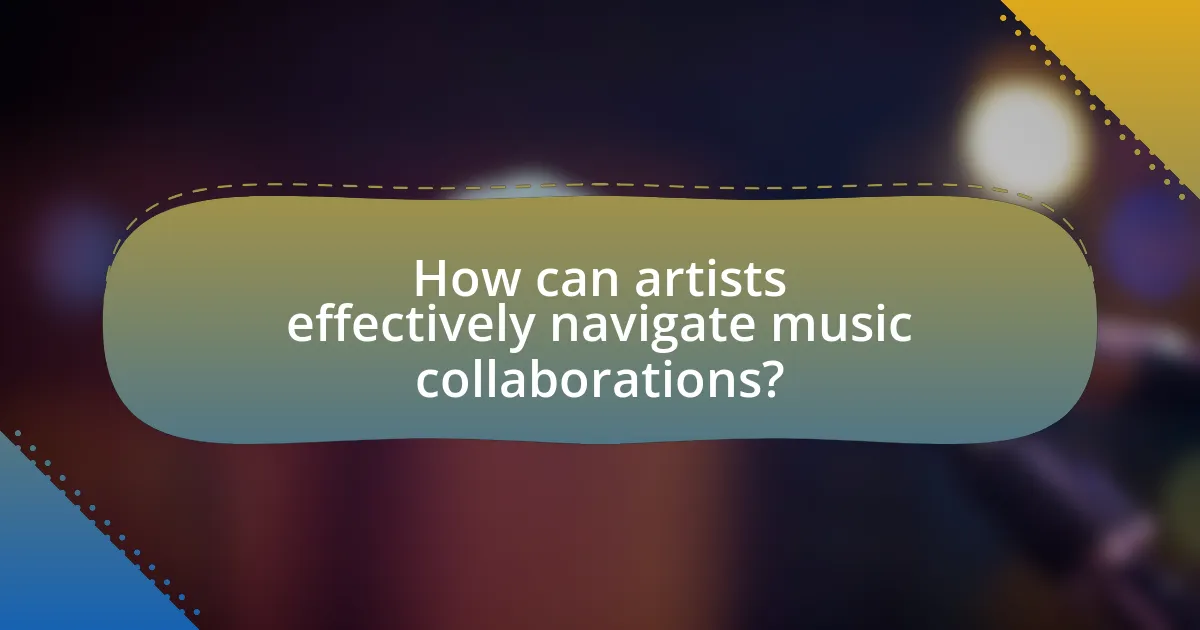
How can artists effectively navigate music collaborations?
Artists can effectively navigate music collaborations by establishing clear communication and setting mutual goals from the outset. Clear communication ensures that all parties understand their roles, expectations, and creative visions, which minimizes misunderstandings and conflicts. Setting mutual goals aligns the collaborators’ efforts towards a common outcome, enhancing the overall productivity of the project. Research indicates that successful collaborations often stem from well-defined agreements regarding creative input, revenue sharing, and credit attribution, which are crucial for maintaining positive relationships and fostering creativity.
What best practices should artists follow when collaborating?
Artists should prioritize clear communication when collaborating, as it establishes mutual understanding and aligns creative visions. Effective communication involves discussing goals, expectations, and roles upfront, which can prevent misunderstandings and conflicts later in the process. Additionally, artists should be open to feedback and flexible in their approach, allowing for a more dynamic and innovative collaboration. Research indicates that successful collaborations often stem from a willingness to compromise and adapt, enhancing the overall creative output. Furthermore, establishing a written agreement detailing contributions, rights, and revenue sharing can protect all parties involved and ensure transparency. This practice is supported by industry standards, which emphasize the importance of formalizing agreements to avoid disputes.
How can clear communication enhance the collaboration process?
Clear communication enhances the collaboration process by ensuring that all participants understand their roles, expectations, and objectives. When team members articulate their ideas and feedback clearly, it minimizes misunderstandings and fosters a more cohesive working environment. Research indicates that effective communication can increase team performance by up to 25%, as it allows for quicker decision-making and problem-solving. In the context of music collaborations, artists who communicate openly about their creative visions and logistical needs are more likely to produce successful projects, as evidenced by numerous successful collaborations in the industry that prioritize clear dialogue.
What strategies can artists use to select the right collaborators?
Artists can select the right collaborators by assessing compatibility in artistic vision, evaluating complementary skills, and considering past collaboration success. Compatibility in artistic vision ensures that all parties share similar goals and creative directions, which fosters a cohesive project outcome. Evaluating complementary skills allows artists to identify collaborators who bring unique strengths, enhancing the overall quality of the work. Additionally, considering past collaboration success provides insight into how well potential partners work together, as evidenced by previous projects that achieved critical or commercial acclaim. For instance, successful collaborations like those between Jay-Z and Kanye West demonstrate the importance of aligning artistic vision and skills, resulting in impactful music that resonates with audiences.
What tools and resources are available for successful collaborations?
Successful collaborations in the music industry utilize tools and resources such as digital audio workstations (DAWs), cloud storage services, and communication platforms. DAWs like Ableton Live and Pro Tools enable artists to create and edit music collaboratively in real-time. Cloud storage services such as Google Drive and Dropbox facilitate easy sharing of project files and assets among collaborators, ensuring everyone has access to the latest versions. Communication platforms like Slack and Zoom enhance coordination and discussion, allowing for effective feedback and brainstorming sessions. These tools collectively streamline the collaborative process, making it more efficient and productive in the evolving landscape of the music industry.
How can technology aid in the collaboration process?
Technology aids in the collaboration process by providing tools that facilitate communication, project management, and creative sharing among artists. For instance, platforms like Splice and Soundtrap allow musicians to collaborate in real-time, regardless of geographical barriers, enabling seamless integration of ideas and resources. Additionally, cloud storage solutions like Google Drive and Dropbox enable easy sharing of files and project updates, ensuring that all collaborators have access to the latest versions of their work. Research indicates that remote collaboration tools can increase productivity by up to 30%, demonstrating their effectiveness in enhancing teamwork and creativity in the music industry.
What platforms are best for connecting with potential collaborators?
The best platforms for connecting with potential collaborators in the music industry include SoundBetter, Splice, and LinkedIn. SoundBetter allows musicians to find and hire professionals for various roles, such as producers and session musicians, facilitating collaboration across different skill sets. Splice offers a community for music creators to share samples and collaborate on projects, enhancing creative partnerships. LinkedIn serves as a professional networking site where musicians can connect with industry professionals, fostering opportunities for collaboration. These platforms are widely recognized for their effectiveness in bridging connections among artists and industry experts.
What common pitfalls should artists avoid in collaborations?
Artists should avoid lack of clear communication in collaborations. Effective communication is essential to ensure that all parties understand their roles, expectations, and creative visions. Misunderstandings can lead to conflicts, dissatisfaction, and ultimately, a failed project. Additionally, artists should be cautious of not establishing a written agreement, as this can result in disputes over ownership, credit, and compensation. According to a survey by the Music Industry Research Association, 70% of artists reported that unclear agreements led to conflicts in collaborations. Therefore, prioritizing clear communication and formal agreements can significantly enhance the success of collaborative efforts.
How can artists manage expectations and responsibilities in a collaboration?
Artists can manage expectations and responsibilities in a collaboration by establishing clear communication and setting defined roles from the outset. This approach ensures that all parties understand their contributions and the project’s goals, reducing the likelihood of misunderstandings. Research indicates that successful collaborations often involve regular check-ins and feedback sessions, which help to align expectations and address any issues promptly. For instance, a study published in the Journal of Music Collaboration found that projects with structured communication protocols resulted in higher satisfaction among collaborators. By prioritizing transparency and accountability, artists can foster a productive collaborative environment.
What are the signs of a successful collaboration versus a failed one?
Successful collaborations in music are characterized by clear communication, mutual respect, and shared goals, while failed collaborations often exhibit misunderstandings, lack of engagement, and conflicting objectives. For instance, successful partnerships typically involve artists who actively listen to each other’s ideas and provide constructive feedback, fostering a creative environment. In contrast, failed collaborations may result from one party dominating the process or failing to contribute, leading to frustration and disengagement. Research indicates that effective collaboration can enhance creativity and innovation, as seen in projects like the 2018 Grammy-winning album “Everything Is Love” by The Carters, which showcased seamless teamwork and aligned artistic vision.

